Introduction.
As in WW1, the Royal Navy again in WW2, to augment its Naval ships made use of selected Merchant ships by converting them to Armed Merchant Cruisers. These vessels ranged from 6,000 to 22,000 tons, and were fitted out, usually with old WW1 type 6 inch guns, complemented with a meagre and totally inadequate Anti-aircraft armament. Given the title of His Majesty's Ship, and a White Ensign to fly these ships were in general, used for convoy escort work, and proved to be no match for any encounter with modern German capital ships.
Unlike the Allied AMC's, the German Navy used their Armed Merchant Raiders in both world wars to devasting effect against single ships steaming alone. I have covered their role in my Marauders of the Sea in WW1 and WW2.
Allied Armed Merchant Cruisers.
Over WW2, Allied Armed Mechant Cruisers numbered 57, two, in the Royal Australian Navy, one, in the Royal New Zealand Navy, and three, in the Royal Canadian Navy, and the balance serving with the Royal Navy. The two RAN ships, plus HMS Kanimbla, who had served with the RN, and reverted to the RAN, were all later converted to Landing Ships Infantry, to work with distinction in a number of Island landing operations in the Pacific arena.
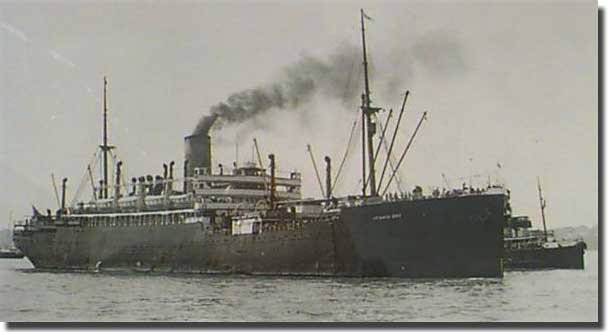
HMS Jervis Bay
Sinkings.
Of the 57 AMC's who served in WW2, to be used on convoy duties, but given their high sides, lack of armour plating, generally slow speed, and poor main armament, they were not up to the task expected of them. These ships in general were inadequate, quite unlike the 8 inch gunned County Class Cruisers who were Maids of all type of work, convoy escorts as both fast and powerful ships, excellent for hunting down and destroying any German Armed Merchant Raider, in Fleet work with other cruisers or aircraft carriers, and as part of Bombardment Task Forces with the United States Navy in the Pacific, they gave magnificent service in any role allocated to them.
I was priviliged to serve in three of these 8 inch gunned ships, Australia, Canberra ( to be sunk in her at Savo ) and Shropshire who replaced her, gifted to the RAN by the Royal Navy.
No match for German capital type ships.
I have already indicated that these AMC's were indeed no match for a major German naval unit, and both Rawalpindi and Jervis Bay were sunk in encounters with Scharnhorst, Gniesenau, and Admiral Sheer respectively, and we will look at those two actions in some detail later.
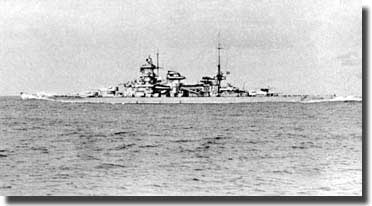
The German Scharnhorst, with Gneisenau accounted for the Armed Merchant Cruiser HMS Rawalpindi
10 Armed Merchant Cruisers were despatched by U-Boats in the Battle of the Atlantic, at different locations and times.
Voltaire had a fight with the German Armed Mercahnt Raider Thor, and soon lost.
HMS Hector whilst in Colombo harbour was subjected to an air raid carried out by Japanese carrier aircraft to be set on fire and destroyed on the 4th. of March 1942.
Comorin was destroyed by fire in the North Atlantic on the 4th. of June 1941.
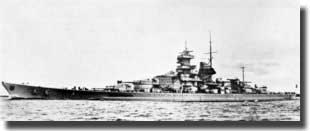
Gneisenau, in action against the British AMC, Rawalpindi, 3rd. of November 1940.
HMS Rawalpindi sunk.
This 16,700 ton steamship had launched on the 26th, of March in 1925, she was one of four Peninsula and Orient Navigation Company ships to be requisitioned by the Admiralty for conversion to AMC status. She became HMS Rawalpindi, and was part of the Northern Patrol stationed South East of Iceland in November of 1939, with Captain E. C. Kennedy in command.
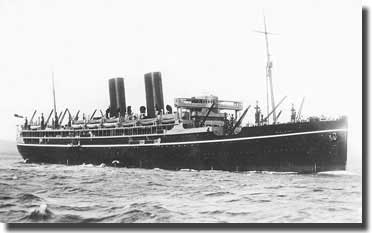
Rawalpindi in her peacetime livery, prior to becoming an Armed Merchant Cruiser.
3rd. of November 1939.
On the afternoon of the 3rd. of November 1939, whilst Rawalpindi was on her patrol beat South East of Iceland at 1530 ( 3.30 PM ) she ran slap bang into not one German capital ship, but two, Scharnhorst and Gneisenau, her goose about to be cooked.
Captain Kennedy immediately ordered a smoke screen to be laid hoping to sneak into a fog bank on his port bow. But escape proved quite impossible as Scharnhorst fired a warning shot across his bows, ordering him to stop his ship, he ignored that order, and it was followed up with an 11inch gun salvo fired from some 10,000 yard range.
Kennedy now ckeekily opened fire with four of his paltry 6 inch guns, salvoes from Scharnhorst burst upon Rawalpindi, and now Gneisenau joined in the slaughter. But still Rawalpindi defied the odds, and continued to fight the two mighty German ships, it was all over in 40 minutes, three boats were lowered from the stricken AMC as those still able, abandoned ship. Two boat's crews were picked up by the Germans, and the third were rescued by Chitral, another AMC close by.
Only 38 survived.
238 crew died including Captain Kennedy, who was the father of broadcaster and author Ludwig Kennedy. Rawalpindi was the first of 15 AMC's to die in WW2. Her Captain was to mentioned in despatches.
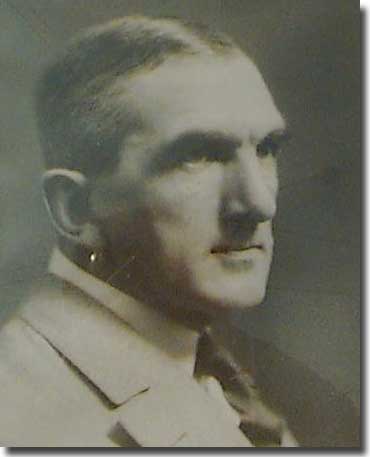
Captain. Edward Stephen Fogarty Fegen. Victoria Cross.
The hero of the action between HMS Jervis Bay and the German Admiral Scheer
The sacrifice of HMS Jervis Bay.
Jervis Bay was built at Vickers Ltd at Barrow in Furness in 1922, originally to carry emigrants across the world to Australia, this passenger ship was requisitioned by the Admiralty in September 1939. The 14,164 ton ship to become HMS Jervis Bay, an Armed Merchant Cruiser mounting 7 by 6 inch guns of WW1 vintage, and 2 by 3 inch AA guns. Her speed, a modest 15 knots.
Convoy HX 84, Halifax to UK.
Jervis Bay sailed out of Halifax, the sole escort for 38 ships forming Convoy HX 84, on the 28th. of October 1940. In the Geman pocket battleship Admiral Scheer, her Captain Krancke, with his ship's 11 inch guns had learned through Naval intelligence that HX 84 was on its way, and his ship stood directly in their path.
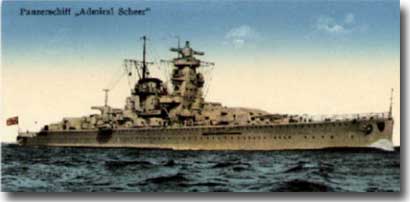
German Admiral Scheer
On the morning of the 5th. of November the ship's Arado aircraft on a scouting flight sighted the convoy, but lookouts afloat did not spot this plane, which scurried back home to report its find.
Now Admiral Scheer ran into the 6,000 ton banana ship SS Mopan, it was essential that she was silenced before she could raise the alarm and warn the nearby convoy. Scheer used a signal lamp to order this ship to stop, and maintain radio silence, she suprisingly obliged, her crew to be taken off, and the ship consigned to the depths of the Atlantic Ocean. Now lookouts in Jervis Bay sighted an unknown ship, and Captain Fegan had his signalman send off, What Ship? Of course no response, so the question was repeated as he was expecting to soon join up with his ocean escort.
At 1730 ( 5. 30 PM ) the unidentified ship turned broadside on, about 8 miles away, and then opened fire, this salvo falling close to Jervis Bay.
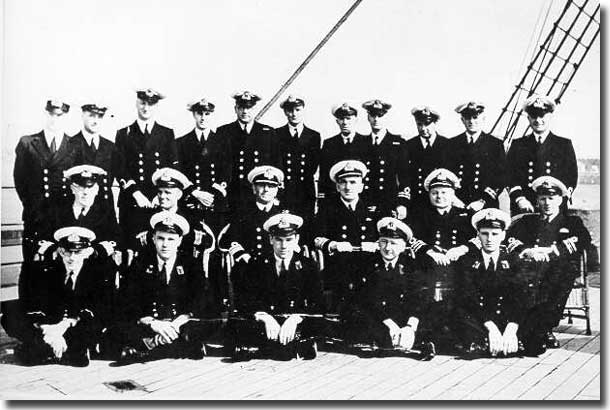
Officers of the ill fated HMS Jervis Bay, sunk by the German pocket battleship Admiral Sheer 5th. of November 1940
Convoy ordered to scatter.
Now the danger was apparent, Fegan (Corrected from Kennedy thanks to Vince Matthews) ordered his charges to scatter, dropped smoke floats trying to obscure the target from the German gunners. The AMC opened fire with her forward 6 inch guns, but this obsolete armament was still out of range, a German salvo struck the fore part of Jervis Bay , now her bridge was hit, destroying her gunnery control, and the Captain lost an arm.
The ship, mortally stricken was starting to sink by her bow, it was time to leave as "Abandon Ship" was ordered. The AMC quickly sank into the dark depths of the grim Atlantic Ocean, taking 187 crew members including the Captain with her. It was all over in about 22 minutes, but she had won time for the bulk of the convoy to escape, Sheer sank a further 5 of the convoy ships, but the Swedish ship Stureholm risking her own safety, stopped to collect 65 sailors from Jervis Bay. Unfortunately this brave ship was herself sunk by U-Boat U-96 on the 15th. of December 1940.
Fegan was awarded a posthumousVictory Cross for his gallant fight and sacrifice which saved many of Convoy HX 84.
Conclusion.
Although much good work was achieved by the Allied Armed Merchant Cruisers of WW2, they really were sitting ducks in any action against an enemy capital ship, and the U-Boat was their mortal enemy claiming 10 of their number.
The plucky fight of two of their Captains won them the highest award of their country, the Victoria Cross, but they needed to sacrifice their own lives to be so awarded.
The list of all 57 Armed Merchant Cruisers of WW2.
Royal Australian Navy
Manoora
Westralia
Royal New Zealand Navy
Monowai
Royal Canadian Navy
Prince David
Prince Henry
Prince Robert
Royal Navy
Alaunia
Alcantara
Andania (lost on 16 June 1940)
Antenor
Antonia
Arawa
Ascania
Asturias
Aurania
Ausonia
Bulolo
California
Canton
Carinthia (lost on 6 June 1940)
Carnarvon Castle
Carthage
Cathay
Cheshire
Chitral
Cilicia
Circassia
Comorin (lost on 6 April 1941)
Corfu
Derbyshire
Dunnottar Castle
Dunvegan Castle (lost on 27 August 1940)
Esperance Bay
Forfar (lost on 2 December 1940)
Hector (lost on 5 April 1942 during the Japanese Indian
Ocean raid)
Jervis Bay (lost on 5 November 1940)
Kanimbla
Laconia
Laurentic (lost on 3 November 1940)
Letitia
Maloja
Montclare
Mooltan
Moreton Bay
Patroclus (lost on 4 November 1940)
Pretoria Castle (converted to the escort carrier HMS
Pretoria Castle)
Queen of Bermuda
Rajputana (lost on 13 April 1941)
Ranchi
Ranpura
Rawalpindi (lost on 23 November 1939)
Salopian (lost on 13 May 1941)
Scotstoun (lost on 13 June 1940)
Transylvania (lost on 10 August 1940)
Voltaire (lost on 4 April 1941)
Wolfe
Worcestershire
List of the fifteen Armed Merchant Cruisers lost in WW2.
ANDANIA (R, 13,950t, 1922, AMC from 11/39) Sunk by U-boat torpedo, SE of Iceland, 40/06/16
CARINTHIA (R, 20,277t, 1925, AMC from 1/40) Sunk by U-boat torpedo, W of Ireland, 40/06/07
COMORIN (R, 15,241,1925, AMC from 1/40) Destroyed by fire, N Atlantic, 41/04/06
DUNVEGAN CASTLE (R, 15,007t, 1936, AMC from 12/39) Sunk by U-boat torpedo, W of Ireland, 40/08/28
FORFAR (R, 16,402t, 1922, AMC from 11/39) Sunk by U-boat torpedo, W of Ireland, 40/12/02
HECTOR (R, 11,198t, 1924) Bombed and set on fire during Japanese carrier aircraft raid on Colombo, 42/04/03
JERVIS BAY (R, 14,164t, 1922, AMC from 10/39) Sunk by "Admiral Scheer", N, Atlantic, 40/11/05
LAURENTIC (R, 18,724t, 1927, AMC from 10/39) Sunk by U-boat torpedo, NW Approaches, 40/11/03
PATROCLUS (R, 11,314t, 1923, AMC from 1/40) Attacked by U-boat on the 3rd Sank W of Ireland, 40/11/04
RAJPUTANA (R, 16,641t, 1926, AMC from 12/39) Sunk by U-boat torpedo, W of Iceland, 41/04/13
RAWALPINDI (R, 16,697t, 1925, AMC from 10/39) Gunfire of German battlecruiser "Scharnhorst" SE of Iceland, 39/11/23
SALOPIAN (R, 10,549t, 1926, AMC from 10/39) Sunk by U-boat, torpedo, N Atlantic, 41/05/13
SCOTSTOUN (R, 17,046t, 1925, AMC from 9/39) Sunk by U-boat torpedo NW Approaches, 40/06/13
TRANSYLVANIA (R, 16,923t, 1925, AMC from 10/39) Sunk by U-boat torpedo, N of Ireland, 40/08/10
VOLTAIRE (R, 13,301t, 1923, AMC from 1/40) Gunfire of German surface raider, mid-Atlantic, 41/04/04
The casualty List for HMS Jervis Bay may be found at this URL:
http://www.internet-promotions.co.uk/archives/caithness/jervisbaycasualties.htm
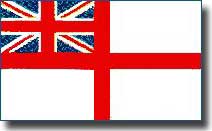
The British White Ensign worn by all of the 57 Allied Armed Merchant Cruisers of WW2
The British White Ensign worn by all of the 57 Allied Armed Merchant Cruisers of WW2








